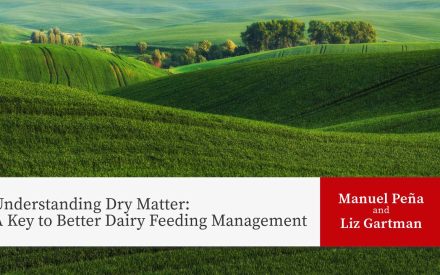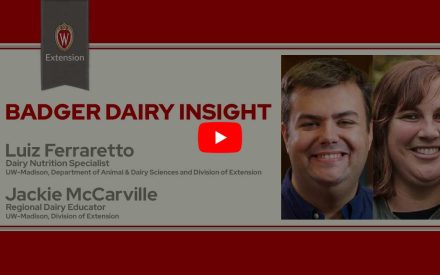This article originally appeared in the January 2024 issue of the Midwest Forage Association’s newsletter, “Clippings.”
“You cannot manage what you do not measure.” Forage testing is a part of the gold standard of consistently achieving good production/performance levels using the forage that you have available. While you can formulate a ration based on expected performance and assumed values, you are relying on averages to help you achieve herd performance goals. This method relies on the fact that you are assuming your forage is achieving at least the average values based on whichever laboratory averages, research reference, etc. that you or your nutritionist are relying on. The result may be a ration that is missing the mark, leaving pounds of milk on the table, or paying for ingredients that may not have been necessary.
Lactating dairy cows have been shown to eat more dry matter and produce more milk when consuming forages with higher neutral detergent fiber (NDF) digestibility. The NDF digestibility is an estimate of the amount of total NDF that the cow and microbes in the digestive tract can utilize before the forage material is expelled from the cow as manure. Since NDF digestibility decreases as forages mature, this is one reason that we have seen high-producing herds shift to a less mature crop for ensiling compared to what the normal may have been 30 years ago.
Key Take-Home Message: Why forage test?
- More economical ration
- More pounds of milk
- Forage tests are relatively inexpensive
What should I choose: laboratory chemistry, wet chemistry, or near-infrared spectroscopy?
When using forage testing, there are many different types of analysis that can be completed. Laboratory chemistry and digestive chemistry (wet chemistry) have been the industry standard for learning about the characteristics of the forage being tested. While considered more accurate, wet chemistry is more expensive and slower to get results. Near Infrared (NIR) has become a popular analysis method due to the quick turn-around time to complete and are less expensive.
Why might you want to choose one type of testing method over another? When measuring an alternative forage (not standard corn silage, alfalfa or grass-based silage), you may not want to utilize NIR as the reference calibration database may not be as robust as that of the standard forages, creating less reliable results. For forages that are commonly used and tested regularly, NIR results generated by a laboratory will generally be adequate for routine use.
If you are evaluating mineral content in your forage to help with DCAD balancing for transition diets, laboratory chemistry is going to give you more accurate results. Forage testing using NIR is relying on light reflectance which works the best with large molecules such as fiber and protein. Minerals on the other hand tend to be smaller, so NIR will have a harder time giving an accurate result. Digestive chemistry and standard laboratory chemistry are always going to be more accurate compared to NIR.
How do I use my forage test results?
Having a forage test also allows us to target the right feedstuffs to the right group of animals. This can be especially important if we know that there is variability in the forage we harvested. Knowing what we actually have allows us to feed the quality of forage to the group where it will be most effective. High-producing animals may see a greater response to high NDF digestibility forage compared to lower-productivity animals.
Forage testing can also help us monitor mineral levels in our forages. Potassium levels are a critical piece of the puzzle to monitor when formulating dry and transition cow diets. Potassium levels in your forage test can be a reflection of the nutrient levels present in your soil. Forages low in potassium are ideal for feeding to pre-fresh cows during the last three weeks prior to calving. Once the cow has calved, her potassium demands increase with lactation and she is more able to utilize higher potassium content that is often found in harvested forages.
Going beyond a standard chemistry forage test may well be worth the extra cost of completing a digestive chemistry test to get a better understanding of where your forage NDF digestibility is at. This could allow you to tailor feeding higher-producing animals higher NDF digestibility forages.
Forage testing also has another application: you can get a better idea of if your forage fermented correctly if ensiled, you can elect to test for contaminants if you know there are potential yeast, mold, or toxin issues, etc. More information on this topic can be found at https://bit.ly/ForageStability. Sampling your forage also gives you an opportunity to simultaneously work with a nutritionist to evaluate particle length or request a particle length evaluation in addition to your analysis to make notes about adjusting the cut length for the future.
Forage testing has the potential to allow you to more effectively utilize your forages. Using test results can help you realize more pounds of milk from your cows by helping you decide where to best use your forages and how to complement them in your ration. Using forage testing is a relatively inexpensive way to maximize your efficient use of forage.
References:
“Understanding NDF Digestibility of Forages.” 2001. Access at https://fyi.extension.wisc.edu/forage/files/2016/10/NDFDig-2.pdf.
“Target the right quality forage to the right cows.” 2023. Access at https://hoards.com/article-34136-target-the-right-quality-forage-to-the-right-cows.html.
“Using lab tests to estimate forage stability and fermentation efficiency.” 2023. Access at: https://dairy.extension.wisc.edu/articles/using-lab-tests-to-estimate-forage-stability-and-fermentation-efficiency/.
Reviewed by: Jackie McCarville, Extension Regional Dairy Educator in Grant, Green, Iowa, & LaFayette Counties; Matt Lippert, Extension Dairy Educator in Clark & Wood Counties


 Understanding Dry Matter: A Key to Better Dairy Feeding Management
Understanding Dry Matter: A Key to Better Dairy Feeding Management Healthy Cows: Nutrition Recommendations for Transition Periods
Healthy Cows: Nutrition Recommendations for Transition Periods ▶️ Watch: Cows need fiber too! Storage and feeding tips to minimize nutrient losses
▶️ Watch: Cows need fiber too! Storage and feeding tips to minimize nutrient losses Protein, What Is It? And Why Do Cows Need It?
Protein, What Is It? And Why Do Cows Need It?


